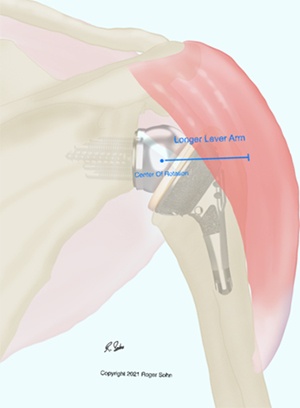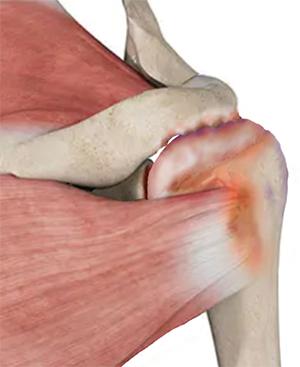
REVERSE SHOULDER REPLACEMENT SURGEON with offices in SAN JUAN CAPISTRANO and FOUNTAIN VALLEY CA
Reverse shoulder replacement offers restoration of function to individuals with shoulder arthritis and rotator cuff damage as well as several other painful shoulder conditions. Dr. Sohn provides diagnosis and individualized nonoperative and operative treatments for the shoulder including reverse shoulder replacement, serving the communities of Mission Viejo, Laguna Niguel, Dana Point, San Clemente, San Juan Capistrano and Fountain Valley CA. Dr. Sohn also provides the highest level of care during and after surgery. Contact Dr. Sohn’s office for an appointment today!
What is Reverse Shoulder Replacement?
By Roger Sohn, MD
Total shoulder replacement offers patients with shoulder arthritis a renewal of their joint function and mobility. When successful, patients often describe the results as revolutionary or miraculous. However, this type of surgery was previously only available for patients who had a fully functional set of muscles called the rotator cuff. Furthermore, in those patients who had severe socket bone damage from years of living with arthritis, the traditional shoulder replacement became impossible to due from lack of support for the new socket.
Reverse total shoulder replacement is an advanced surgical technique specifically designed to solve these problems. It is called a “reverse shoulder” because it involves placing a ball where the native socket was and placing a socket where the humeral “ball” was. I’ll explain the design and function in this article.
What are the Differences Between Anatomic and Reverse Shoulder Replacement?

Conventional shoulder replacement surgery involves replacing the ball of the humerus with a metal ball and the glenoid “socket” of the shoulder blade (scapula) with a plastic socket. We also call this the “anatomic total shoulder replacement” because it mimics the normal anatomy. The normal shoulder is a very loose or shallow ball and socket joint. The shoulder is stabilized by the surrounding muscles called the rotator cuff. Without the rotator cuff to stabilize the newly replaced shoulder, the ball and socket develop excess motion known as the “rocking horse phenomenon”. This excessive rocking of the glenoid component leads to early failure of the anatomic implant. Therefore, the reverse shoulder replacement was designed to solve these problems.
In reverse total shoulder replacement, the placement of the artificial components is essentially reversed. In other words, the humeral ball is placed in the glenoid cavity of the shoulder blade (scapula) and the socket is placed on top of the arm bone. This design makes efficient use of the deltoid muscle, the large shoulder muscle, by giving it a longer lever arm to pull on. It also takes advantage of the large volume of the humerus, allowing the placement of a deep-dish socket which is much more stable than the native shoulder. This stabilizes the shoulder and prevents the “rocking horse phenomenon”. The deep-dish is so stable that a functioning rotator cuff is not necessary.
Who are Candidates for Reverse Shoulder Replacement?

Rotator Cuff Tear Arthropathy
Reverse total shoulder replacement opens the door for many patients who previously were not candidates for the surgery. Patients who can benefit from the surgery include those with:
- A completely torn rotator cuff that is difficult to repair
- A chronic rotator cuff tear with arthritis and instability (aka rotator cuff arthropathy)
- Shoulder arthritis in combination with a rotator cuff tear
- Previous unsuccessful shoulder replacement
- Severe shoulder arthritis with loss of bone from the socket
How is a Reverse Shoulder Replacement Procedure Performed?
Reverse total shoulder replacement surgery is performed usually as an outpatient procedure. Occasionally, patients may be kept in the hospital or surgery center for overnight observation. The surgery is done under general anesthesia. The anesthesiologist will usually place a nerve block to reduce the postoperative pain for about a day after surgery.
- Dr. Sohn makes an incision over the affected shoulder to expose the joint.
- The humerus is separated from the glenoid socket of the scapula.
- The arthritic parts of the humeral head and the socket are removed and prepared for the insertion of the artificial components.
- The new metal ball is attached to the shoulder socket and the cup component is press fit into the humerus.
- The tissues are approximated and the wound is closed with sutures.
Postoperative care for Reverse Shoulder Replacement
You can get out of bed on the same day of the surgery. Most patients are discharged the same day of surgery to recover at home. Patients are encouraged to use the sling we provide. They should take their prescribed medications to manage pain and to avoid side effects. Physical therapy starts about 1 week after surgery. Patients are instructed on the restrictions which need to be observed for 6 weeks after surgery.
Risks and Complications of Reverse Shoulder Replacement
The possible risks and complications associated with reverse total shoulder replacement surgery include:
- Infection
- Dislocation or instability of the implanted joint
- Fracture of the humerus or scapula
- Damage to nerves or blood vessels
- Blood clots (deep vein thrombosis)
- Arm length discrepancies
- Wearing out of the components
What are the Results After Shoulder Replacement?
Generally, patients are allowed to return to normal activities 3 months after a reverse shoulder replacement. However, it takes about 1 year for the shoulder blade to gain full strength and density from the new forces the deltoid is exerting. Stress fractures can occur if heavy lifting is attempted too early. After the shoulder blade has had adequate time to strengthen, all activities are allowed.
Read more about our patient results about our patient results.
Dr. Sohn discusses anatomic vs. reverse Shoulder replacements.

